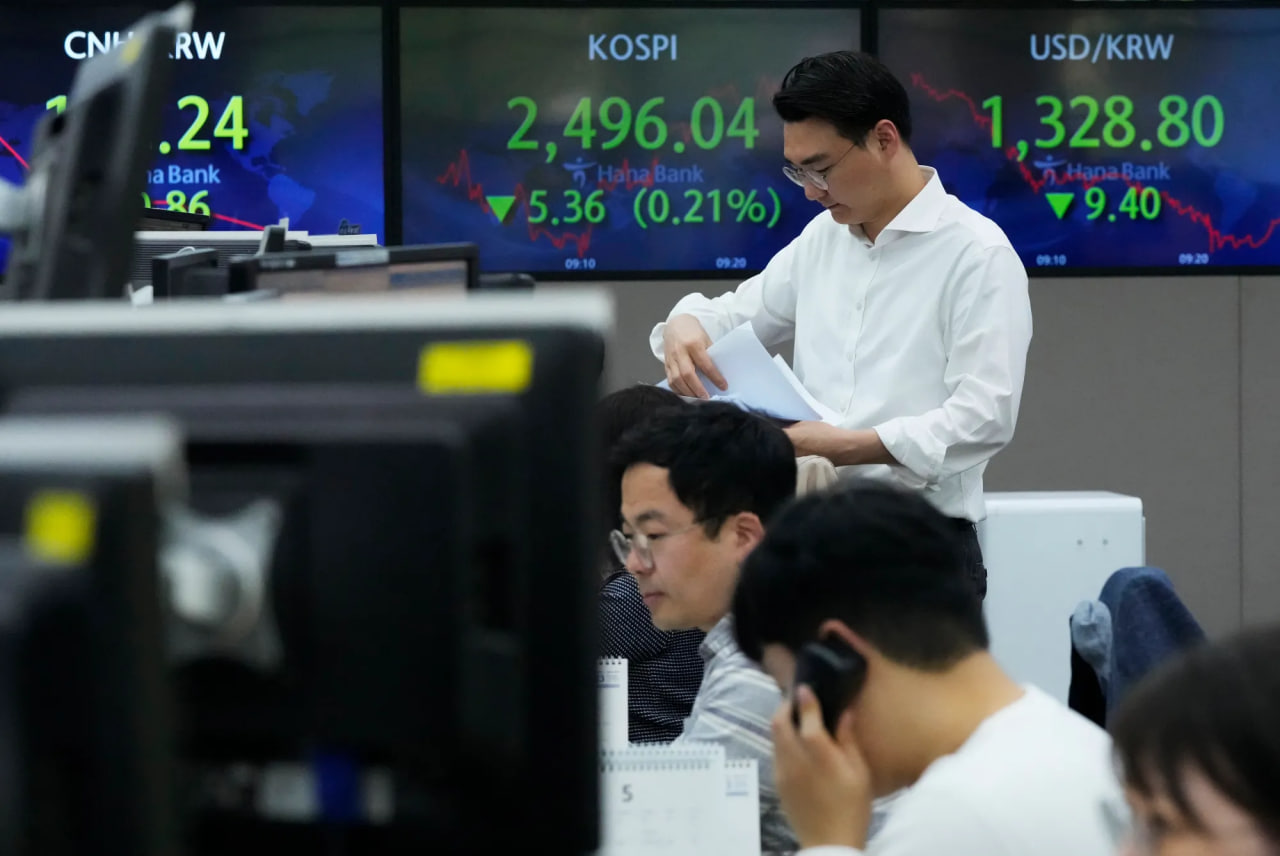Brazil's Real Takes a Tumble: Understanding the Plunge Below 6.2 Against the Dollar
Meta Description: Deep dive into the recent significant drop of the Brazilian Real (BRL) against the US dollar (USD), exploring the underlying economic factors, geopolitical influences, and potential future implications for investors and businesses. We analyze the causes, effects, and predictions for the BRL/USD exchange rate, offering expert insights and actionable advice. #BrazilianReal #USD #BRLUSD #Forex #BrazilianEconomy #EmergingMarkets #CurrencyExchange #Investment
Imagine this: You're planning a dream vacation to Rio de Janeiro, meticulously budgeting your trip. Suddenly, the exchange rate shifts, and your hard-earned savings buy you significantly fewer Reais. Ouch! That's the harsh reality many are facing due to the recent dramatic fall of the Brazilian Real against the mighty US dollar. The BRL plummeted below the crucial 6.2 mark, a significant drop that has sent ripples throughout the Brazilian economy and beyond. This isn't just another blip on the financial radar; it's a seismic shift with far-reaching consequences. This in-depth analysis will dissect the factors driving this decline, assess its impact on various sectors, and offer a glimpse into what the future might hold for the BRL. We'll navigate the complexities of international finance, avoiding jargon, and focusing on providing you with clear, actionable insights. Forget dry economic reports; we'll unpack this story with real-world examples, expert opinions, and a dash of human interest, painting a compelling picture of this significant market event. Get ready to unravel the mystery behind this major currency fluctuation and learn how to navigate this volatile landscape. Let’s dive in!
The Brazilian Real's Freefall: Analyzing the Causes
The recent depreciation of the Brazilian Real is a complex issue, a perfect storm brewed from various interconnected factors. It's not a single cause-and-effect scenario but rather a confluence of economic realities and geopolitical events. Let's break down the key contributors:
-
Global Economic Uncertainty: The global economy is, to put it mildly, a rollercoaster right now. High inflation in many developed nations, rising interest rates, and the lingering impact of the war in Ukraine have created a flight to safety, with investors seeking refuge in stable currencies like the US dollar. This increased demand for the dollar inherently weakens other currencies, including the Real. Think of it like this: everyone wants a piece of the "safe haven" pie, leaving less demand for the BRL.
-
Domestic Economic Challenges: Brazil, despite its vast resources and vibrant economy, faces its own set of internal hurdles. Inflation, though showing signs of easing, remains a significant concern. Political instability, while seemingly less intense than in previous years, still casts a shadow of uncertainty over investor confidence. A sluggish growth rate doesn't exactly inspire bullish sentiment, does it?
-
Commodity Prices: Brazil is a major exporter of commodities, and fluctuating prices play a significant role in the Real's value. When commodity prices fall, the country earns less foreign currency, impacting the BRL's strength. Recent trends in commodity markets haven't exactly been favorable for Brazil, adding further pressure to the currency.
-
Interest Rate Differentials: The difference between Brazil's interest rates and those of other countries, particularly the US, significantly impacts currency exchange rates. Higher interest rates in the US attract foreign investment, boosting the dollar's value and putting downward pressure on the Real.
-
Geopolitical Factors: Global events, especially those impacting major trading partners, can significantly ripple through the currency market. The ongoing geopolitical tensions globally add another layer of uncertainty, influencing investor behavior and impacting the Real's value.
Table: Key Factors Affecting the BRL/USD Exchange Rate
| Factor | Impact on BRL | Explanation |
|--------------------------|-------------------------------------------|------------------------------------------------------------------------------------|
| Global Economic Uncertainty | Negative | Flight to safety towards USD |
| Domestic Economic Challenges | Negative | Inflation, political uncertainty, slower growth |
| Commodity Price Fluctuations | Negative (if prices fall) | Reduced foreign currency earnings |
| Interest Rate Differentials | Negative (US rates higher than Brazil's) | Increased investment in US, strengthening USD |
| Geopolitical Factors | Negative (during periods of heightened tension) | Uncertainty leads to risk-averse investor behavior |
The Ripple Effect: Impact on Businesses and Individuals
The weakening Real has widespread implications, affecting businesses and individuals alike. Exporters might initially benefit from increased competitiveness in global markets, but a prolonged weakening can lead to higher import costs, impacting profitability. Importers face the brunt of the impact, as the increased cost of imported goods can lead to price hikes for consumers. Travelers planning trips to Brazil find their budgets stretched thinner, and businesses relying on imports see their margins squeezed. It's a domino effect, with each sector feeling the weight of this currency shift.
Navigating the Volatility: Strategies for Investors and Businesses
For investors, the volatility presents both challenges and opportunities. Diversification is key; relying solely on BRL-denominated assets is risky in this climate. Hedging strategies, such as using derivatives, can help mitigate losses. For businesses, careful planning and risk management become paramount. Strategies like currency hedging, diversified sourcing, and flexible pricing models can help navigate these turbulent waters. Staying informed is crucial; staying abreast of market trends and economic indicators will help you make informed decisions. It's crucial not to panic, but to adopt a measured, well-informed approach.
Frequently Asked Questions (FAQs)
Q1: How long will the Real's decline last?
A1: Predicting the future of any currency is tricky business. The duration of the Real's decline depends on several factors, including global economic conditions, domestic policies, and geopolitical events. While some experts predict a stabilization, others foresee further depreciation. It's a complex equation with no easy answers.
Q2: What can the Brazilian government do to strengthen the Real?
A2: The government can employ various monetary and fiscal policies. Raising interest rates can attract foreign investment, but it also risks slowing economic growth. Fiscal reforms aimed at improving the budget deficit can also boost investor confidence. The government's choices demand a delicate balancing act.
Q3: Is this the worst we've seen for the BRL?
A3: While this current decline is significant, the Real has experienced sharper drops in the past. Historical context is essential; putting this situation in perspective within a broader timeframe is crucial before drawing conclusions about its severity.
Q4: Should I avoid investing in Brazil altogether?
A4: Not necessarily. Brazil remains a large and diverse economy with significant long-term potential. However, a cautious approach, with proper risk management and diversification, is essential.
Q5: How does this affect Brazilian tourism?
A5: The weaker Real makes Brazil a more affordable destination for international tourists but increases the cost for Brazilians traveling abroad. It's a double-edged sword, impacting both inbound and outbound tourism.
Q6: What are some reliable sources for tracking the BRL/USD exchange rate?
A6: Major financial news websites (like Bloomberg, Reuters, and the Financial Times), central bank websites, and specialized forex trading platforms provide real-time data and analysis.
Conclusion
The recent fall of the Brazilian Real below 6.2 against the US dollar is a complex event with multiple contributing factors. While this situation presents challenges for businesses and individuals alike, it also presents opportunities for savvy investors and adaptable companies. Understanding the underlying causes, staying informed about market trends, and employing appropriate risk management strategies are crucial for navigating this volatile landscape. The future of the BRL remains uncertain, but remaining flexible and adaptable will prove beneficial in the long run. Remember, knowledge is power, and in the unpredictable world of international finance, informed decision-making is your strongest weapon.



